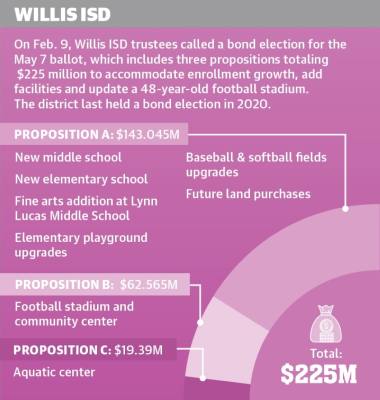According to an April 2021 report from demographics firm Population and Survey Analysts, WISD is projected to enroll 6,000 more students by the 2030-31 school year with several schools exceeding capacity by that time. This includes Turner and Meador elementary schools, Brabham Middle School and Willis High School.
“A second high school is going to have to come into the conversation,” Superintendent Tim Harkrider said in an interview.
WISD trustees voted Feb. 9 to place three propositions on the May ballot that would yield a tax rate increase of $0.05 per $100 of valuation if all are approved, although a statewide proposition also on the ballot to raise the homestead exemption could result in overall tax savings regardless.
Proposition A totals $143 million for a middle school, an elementary school, a fine arts addition at Lynn Lucas Middle School, baseball and softball fields, playground equipment and land, according to WISD.
Proposition B totals $62.56 million for a football stadium and a community room, and Proposition C totals $19.39 million for a natatorium—or aquatic center—to support the district’s swimming and diving programs. Students currently must travel to an outdoor pool in Shenandoah.
“If we have those clubs and we have those sports, we should have facilities that go along with the coinciding sport,” WISD parent Ashlee Cooper said.
Athletics facilities
While projects are still wrapping up from the $100.1 million bond approved in 2020, Harkrider said replacing the 48-year-old stadium and building an aquatic center were initially discussed in 2020.
Harkrider said trustees included a stadium in the bond called in May 2020. However, based on economic conditions at the time, trustees called a new bond for November 2020 after May elections were postponed, which did not include a stadium and aquatic center as originally approved.
“It is not a new discussion,” Harkrider said. “Just in two short years with the pandemic, the price escalation is astronomical.”
According to WISD’s 2020 bond website, the proposition pitched in May 2020 for a stadium and other athletics field upgrades totaled $62.35 million, whereas the stadium alone is anticipated to total $62.56 million in 2022. Additionally, the natatorium was $12.5 million in 2020 and is anticipated to cost $19.39 million in 2022.
Harkrider said the existing Yates Stadium was given a “fair” rating in 2020 and is one of the last concrete-pillar stadiums in Texas, which requires a review every two years and costly repairs.
“It’s never going to improve the condition from fair to good; you’re just prolonging the life of the stadium,” Harkrider said.
During the March 25 Lake Conroe Region Outlook event, Harkrider said WISD has spent more than $400,000 over the last six years repairing Yates, which can no longer accommodate the number of spectators.
“Now that we’re in 6A and we’re competing with 6A schools, we need those resources available to our students like other school districts have in order to compete,” Cooper said.
Cara McCollum, owner of Grace Goods Boutique on FM 830 and a WISD parent, said the bond would help students have an even playing field with other schools. She also said she believes the aquatic center included in the bond will benefit the school and the community since it will be the first swim facility nearby.
“That was one thing our long-term planning committee really rallied around was that this could really have a positive impact on our overall community, not just swimming and diving,” Harkrider said.
Financial impact
Jeffery Clemmon, director of facility services at the Texas Association of School Boards, said growing districts have limited funds.
“The way that the state funds schools today, they do not have the funds available through their [maintenance and operations tax] or standard tax allotment from the state to build new schools, renovate schools [or] even ... to maintain properly the facilities that they have,” he said. “The only way that they can build new schools, renovate facilities in poor condition, retro-fit old or aging building systems is to go out for a bond proposal.”
Harkrider said bond funds cannot be used for daily operations, such as salaries, which are funded by the maintenance and operations tax rate.
While the approval of the bond propositions would result in a tax increase, the district’s rate has decreased $0.21 since the 2018-19 school year to $1.172 per $100 of valuation in 2021-22, according to WISD. The tax rate would not increase, regardless, for residents age 65 and older with an exemption.••Harkrider said voting against the bond does not negate the need for new facilities. Projects would have to be funded from the operational budget instead.
“If you’re voting ‘no,’ ... you’re voting ‘yes’ to secondary plans. ... The more money that we have to spend on temporary solutions, ... the less money we’ve got to go to other places,” he said. “For us to grow and thrive as we are, we’ve got to have resources for our students.”
Maegan Kirby contributed to this report.







